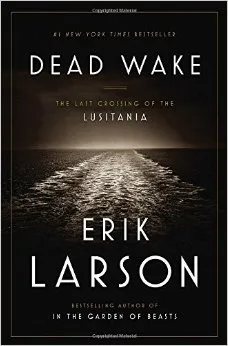This Map Shows the Full Extent of the Devastation Wrought by U-Boats in World War I
On the anniversary of the sinking of the Lusitania, a look at how “unrestricted submarine warfare” changed the rules of war
It was a foggy morning as Captain William Turner navigated the RMS Lusitania through the final and most precarious leg of its voyage from New York City to Liverpool, England. On May 7, 1915, the British ocean liner had just entered the German-declared “unrestricted submarine warfare” zone, which deemed any ship, even civilian and merchant ones, fair game for attack while within its borders. Turner, however, seemed more worried about the foreboding weather conditions overhead than any covert underwater offensive.
The seasoned 58-year-old captain believed in the abilities of the Lusitania to outrun any submarine, technology that was still considered relatively primitive at the time. As historian Erik Larson writes in Dead Wake, Turner’s New York managers at Cunard, the company that owned the boat, even issued an official statement reassuring the public. “The truth is that the Lusitania is the safest boat on the sea. She is too fast for any submarine. No German war vessel can get her or near her.”
Unfortunately, this confidence was premature.
Later that May afternoon, the German submarine U 20 sent a single torpedo through the side of the Lusitania, triggering an explosion inside the ship, and sinking it within 18 minutes. Far from the only vessel victim to such attacks, the Lusitania was one of the most visible in the United States, namely because it held more than 1,900 civilians, and 128 of the nearly 1,200 who died onboard were American. In an attempt to justify the devastating attack, Germany later cited the 173 tons of war munitions the ship had also been carrying.
During World War I, Germany’s unprecedented use of Untersee-boots (U-boats for short) significantly changed the face of the conflict. The European naval power began operating U-boats in 1914, as an alternative to standard warships, which carried the not-insignificant downside of being visible to enemy vessels. The use of submarines led to a merciless form of warfare that increased the sinking of merchant and civilian ships such as the Lusitania.
When it came to capturing merchant ships during wartime, ships that traveled on the surface were required to adhere to specific rules set by international treaties. Any merchant ship that was stopped and discovered to be holding contraband cargo could be captured, boarded and escorted to a designated harbor. Enemy merchant ships could also be sunk, if the crew was allowed an opportunity to use lifeboats.
Since submarines didn’t contain enough people to comprise a boarding party, and revealing their presence would forfeit any advantage, the German Navy ultimately elected for its U-boats to attack merchant and civilian ships indiscriminately. On February 18, 1915, Germany offered “fair notice” to its rivals by declaring “unrestricted submarine warfare” in the waters surrounding the British Isles. This declaration left any ships traveling through the region subject to sudden attacks. As Larson writes in his book, Winston Churchill categorized submarine strikes and the morality behind them as “this strange form of warfare hitherto unknown to human experience.” Per Larson, Britain did not initially believe Germany would go so far as to attack civilian vessels.
The British began to take U-boats more seriously after a major stealth attack decimated three of its large cruisers, the HMS Aboukir, Hogue and Cressy in September 1914. By spring of the next year, Germany had roughly 35 functioning U-boats, many of which utilized torpedoes and had been highly effective in targeting ships passing through their vicinity. As of April 1915, German forces had sunk 39 ships and lost only three U-boats in the process. U-boats played a pivotal role in helping Germany react to the economic offensive that Britain had established with its blockade, by responding in kind and cutting off merchant business and trade.
Early on, many German officials began to believe U-boats would offer a swift and decisive victory to the war. What they didn’t count on was inadvertently inciting American wrath with the attack of a civilian ship.
Prior to the Lusitania's departure from New York, Germany had issued warnings including several ads that ran in major newspapers alerting passengers of the potential danger: “Vessels flying the flag of Great Britain or of any of her allies, are liable to destruction in the waters adjacent to the British Isles…and do so at their own risk.”
However, many passengers adopted Turner’s skeptical attitude given the over 200 transatlantic trips the ship had previously made and its reputation as a speedy “Greyhound” of the sea.
The Lusitania attack put increased public pressure on the Wilson administration to reconsider United States involvement in World War I, leading up to an official declaration of war in 1917. Wilson and Secretary of State William Jennings Bryan were determined to remain neutral in a war they considered driven by European nationalism. Following the Lusitania tragedy, Wilson issued three strongly worded declarations to Germany regarding U-boat warfare, after which submarine attacks on merchants subsided significantly in the Atlantic and shifted to the Mediterranean to assist the Austrians and Turks.
This status was maintained for some time, until early 1917, when Germany decided U.S. involvement in the war was no longer imminent and greater force was necessary to beat back British advances. After the country resumed “unrestricted submarine warfare” once more, Wilson cut diplomatic ties. By the end of World War I, 344 U-boats had been commissioned, sinking more than 5,000 ships and resulting in the loss of 15,000 lives. The might of the U-boat, however, wasn't enough to hold back the combined strength of U.S. and British forces, including the ongoing blockade that ultimately strangled Germany's access to key resources like raw materials and food.
The U-boat data in the above map is courtesy of uboat.net.

/https://tf-cmsv2-smithsonianmag-media.s3.amazonaws.com/accounts/headshot/profile.jpg)